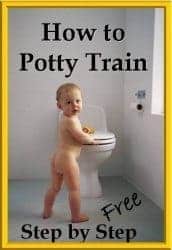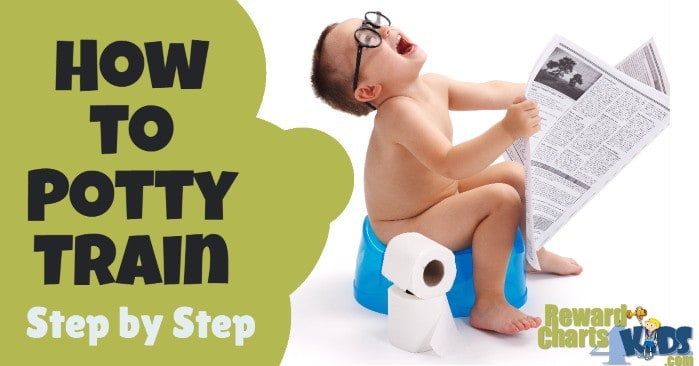How to Potty Train
How to Potty Train Step by Step
Potty training is a milestone that makes parenting a little easier and helps kids to start feeling more independent and grown-up. The potty training process requires a lot of patience, but if you start before your child is ready, then all the patience in the world will not help potty train your child. Although you play an essential part in the process, your child has to be both physically and emotionally ready before you can start potty training him or her.
At what age is a child ready to start potty training?
Your child cannot start potty training until he or she is both physically and emotionally ready. Since each child is a different unique individual, there is no specific age to determine readiness. According to the Mayo Clinic, many children show signs of being ready when they are between 18 and 24 months, but some are not ready until they are 3 or even older. Don’t rush your child into the process as it will only prolong it and make it more frustrating than it has to be for both you and your child.
Even once your child is ultimately potty trained, he or she will still need assistance wiping after a bowel movement until about age 4 or 5. In unfamiliar bathrooms, they might even need help up to age 6 or later.
Is your child ready to start potty training?
Is your child emotionally ready?

Your child should be:
- Interested in using the potty or the toilet.
- Capable of communicating when he or she needs to go.
- Able to understand basic instructions.
Is your child physically ready?
Your child should be:
- Able to take off his or her pants and pull them back up.
- Capable of going to the potty, sitting down and getting up.
- Dry for at least two hours during the day.
If your child can do most of the above, then he or she is probably ready for potty training. If not, it might be better to wait until he or she is ready to prevent unnecessary frustration. Try again in a month or two.
Bowel training is often mastered before bladder training because kids are often aware of the need to go sooner and have more time to respond. On the other hand, some kids find bowel training more difficult and frightening.
When is the best time to start potty training?
Find a time when you will be at home for long periods. Start over a weekend or holiday. If your child is facing a significant change in life, such as the arrival of a new sibling, starting or moving to a new daycare facility, it might not be the best time to start.
Get all of the necessary equipment
Make sure that you have either a potty or toilet seat. If you want to use the toilet and not a potty, then you can purchase a training seat that fits on top of the toilet and makes your child feel more secure and stable. Many kids are worried about falling into the toilet. You can also get a footstep to help them climb up and to have a place to rest their feet.
If you don’t already have the necessary equipment, you might want to take your toddler shopping and allow him or her to choose. It will get him or her involved and excited about the process. If you are going to use training pants, then buy them as well. Some people prefer only to buy training pants once their child has started successfully using the potty for some time. On the other hand, some people never even use training pants. Decide what you are going to buy and then take your child shopping with you. Make sure you let them know how grown up they are and how proud you are of them!
Some people prefer to put underpants underneath their diapers so that they can feel when they are wet. It helps them understand the process. You can buy her underwear with her favorite character and ask her not to get Barbie (or whoever wet). It might help!
Show your child how to use the potty or toilet
Your child will not necessarily know how to use the potty. Show him and let him try himself. Help him take his pants off and just sit on the potty to get used to the idea. Praise him for trying and keep the praise coming!
Once she gets up, explain the importance of washing her hands even if she is not successful. Washing hands after going to the potty or toilet should become a habit, and it is our job to ensure that it does.
Get your child on board
Ask your child if she wants to start potty training before you even begin. If she says yes, then you can get started! Remember, it is her body, and you cannot make her go. You can provide the equipment, show her how to use it, and even help her sit on the potty but you cannot make her go. She needs to be committed (as committed as a toddler can be 🙂 ) or at the least want to start trying.
On the first day, take her to the potty every hour. After about 2 or 3 days, take her to the potty every 2 hours. Praise her for trying even if she is not successful. In addition to the scheduled potty trips, you might have some unscheduled ones when you happen to notice that she needs to go or halfway through an accident. Try and look out for the signs and get to the potty as soon as possible. During the first few days, you might want to keep the potty nearby and not necessarily in the bathroom, particularly if you have stairs on the way to the bathroom or a relatively far way to go. After a few days, you will establish how often you need to schedule potty visits and will not need to go as often.
Make the process fun and enjoyable
Watch potty training DVD’s, read books, sing a potty song in the bathroom, etc. There are many more things that you can do to make it fun, such as adding blue food coloring to the water and watching it change color. Throw a few pieces of cereal in the toilet and try and aim as close to them as possible.
Tell your child that her daughter or teddy bear also wants to be potty trained. Ask her to take him to the potty and help him go. Ask her to show him how it is done.
Keep calm and relaxed and don’t put pressure on your child to complete potty training in less time than it took a sibling or neighbor. Each child is unique and deserves to enjoy this opportunity to “grow up” at his own pace.
Praise, praise, and praise!
Keep telling your child how grown up he is for trying even if he isn’t successful. Using a potty chart will remind you to keep praising and recognizing each successful milestone in the process (such as pulling pants down, sitting on the potty, washing hands). You will find a large selection of free printable potty training charts on this site, and we suggest that you choose one together with your child. Print it out and mark each milestone as you reach it every day. You can also use this site to make a free printable personalized potty training chart with your child’s photo and name. Print her a free potty training certificate to celebrate small achievements as well as bigger ones (staying dry all day or week).
When she is successful, call grandparents and family to tell them. Tell them how big she is and how proud you are. Make a big deal so that she can tell how proud you are and motivate her to continue.
Keep reminding your child to go!
Children often forget to go until it is too late or they are in the middle of their favorite TV program and have to see what happens next (even if it is a program that they have already seen 100 times)! Keep looking for signals that they need to go and remind them to go even if it isn’t convenient for them and might need to stop a game for a few minutes.
Always remind them to go as they wake up in the morning and before you leave home (no matter how short the trip is going to be).
Update other caregivers
If your child goes to daycare, don’t forget to update caregivers and let them know precisely what you are doing so that the potty training process can be consistent both at home and at daycare. Take extra clothes to daycare and your own potty if required. You can either print them a potty training chart to use there or take your own chart from home each day. Try and be consistent and give your child credit for successful potty achievements at daycare too.
Nighttime potty training
Even once your child has mastered potty training in the daytime, he still might not stay dry during the night. Most children only start staying dry all night weeks or months after they are totally potty trained in the day. You can use diapers or disposable training pants at night and only stop using them when they are dry for about ten consecutive nights. After you stop using them and your child starts going to sleep without a diaper or disposable training pants, don’t forget to use a plastic mattress cover at night. You also might always want to make sure that you have clean sheets ready in case you need to change them at night when you are half asleep.
According to NHS, although most kids stay dry all night between the ages of 3 and 5, up to 1 in 5 kids aged 5 sometimes wet the bed.
When things don’t go as planned
Be prepared for accidents since they are bound to happen. Whenever you leave the house, take with a portable potty, wipes and spare clothes.
Don’t get angry when your child has an accident even if you know that it could have been avoided. Tell her that it happens, and next time you know that he will get to the potty sooner.
Sometimes your child will have more accidents than successful potty visits. If there seems to be an improvement over time, then be patient and keep trying. If there appears to be no improvement, then maybe your child is not ready or interested. Give it a break and start again a few weeks later or before then if your child initiates and wants to give it another try. Don’t push her if she isn’t ready.
If your child is potty trained and then starts having regular accidents, you might want to consult with an expert to identify the cause and rule out any problems.

